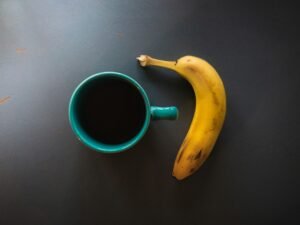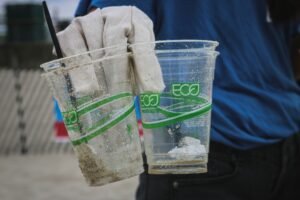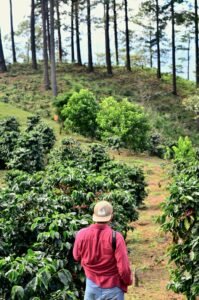From Banana to Espresso: How Colonialism Gets Recycled in Your Cup
In 1954, the United Fruit Company funded a coup d’état in Guatemala to protect its banana business interests. Today, companies like Starbucks and “ethical” certifications perpetuate similar dynamics in the coffee industry — but with more sophisticated marketing. How has colonialism been recycled in the global coffee chain?
Let’s break down three big lies that brands want you to believe.

Lie #1: Colonialism is over
In 1954, the United Fruit Company (UFCO) played a key role in overthrowing Guatemalan president Jacobo Árbenz, who had implemented agrarian reforms that threatened the company’s interests. Through the CIA’s covert PBSUCCESS operation, the coup was justified under the pretext that Árbenz’s government was influenced by communism. This event clearly showed how multinational corporations (backed by the U.S.) could shape the politics of other countries to protect their economic interests.
What sets the United Fruit Company apart from Starbucks? Just the logo.
Today, large corporations like Starbucks and Nestlé continue to exert significant control over coffee producers. These companies buy coffee at very low prices in countries like Honduras, where coffee farmers earn about $0.23 per pound, while a cup of coffee sells for around $5 in cities like New York. They also create their own certifications — like Starbucks’ C.A.F.E. Practices — which are audited internally, raising conflicts of interest and serious questions about transparency.
These dynamics perpetuate a modern form of economic colonialism, where producers are still exploited under the appearance of “fair trade.” The main difference is the sophistication of the tools: brute force has been replaced by marketing strategies and certifications that maintain inequality behind a façade of social responsibility.

Lie #2: Fairtrade = Fair
The Fairtrade seal has been promoted as a guarantee of fair trade for coffee producers. But various studies and farmers’ testimonies reveal that this certification doesn’t always deliver on its promises. One major issue is that only a tiny fraction of the premium price paid by consumers actually reaches the producer. According to a study cited by Qué Café, the extra income a farmer earns by selling coffee with the Fairtrade label is as little as $0.03 per pound.
On top of that, obtaining and maintaining Fairtrade certification involves significant costs for small producers. They have to cover expenses for inspections, certifications, and marketing — a heavy financial burden. In many cases, producers are only able to sell part of their crop as certified, while the rest must be sold at market prices, limiting the benefits they were hoping for.
Certification bodies tend to work with large organizations and businesses that already sell coffee at good prices — even without the seal. This diverts resources and takes up market niches that should support smaller, more vulnerable producers, leaving them further marginalized. These practices call into question the fairness and effectiveness of the fair trade system as a whole.

Lie #3: The “happy” coffee farmer
Coffee brands’ advertising often features images of smiling farmers in traditional clothing, surrounded by idyllic landscapes. This portrayal creates the illusion that — though poor — these workers are happy and content with their lives. But this narrative oversimplifies and hides the complex realities that coffee producers face.
In reality, many coffee farmers live in poverty and face serious challenges, such as low incomes, limited access to basic services, and exposure to labor risks. A report by the Coordinadora Estatal de Comercio Justo highlights that most of the 25 million people who grow coffee live in poverty. In countries like Peru and Ethiopia, coffee farmers’ incomes fall well below the poverty line. These conditions stand in stark contrast to the idealized images shown in ads.
By focusing on a romanticized image of farm work, attention is diverted from the structural inequalities and injustices that persist in the coffee supply chain. It is crucial to recognize and make visible the true living and working conditions of producers — instead of perpetuating a distorted image that benefits large brands at the expense of reality.

Do We Still Believe in “Fair Trade”?
The United Fruit Company used force to silence protests. Today, algorithms and polished certifications are used to maintain the status quo.
This system can change — but it requires all of us to do our part:
🌱 If you consume coffee: Ask questions, do your research, choose brands that show transparency in contracts and pricing (not just pretty labels). Small changes in your purchases can make a big impact.
🌎 If you’re a coffee grower: Your voice matters. Set up online stores to sell directly to consumers — cut out intermediaries and costly certifications.
💡 And if, like me, you believe in a fairer future: Share this information. Let’s talk about what no one shows. Let’s support those who grow with love what so many drink without knowing.
If you discovered that your favorite coffee wasn’t as fair trade as they claimed,
would you be willing to switch?
Research Links
- https://quecafe.info/guia-comercio-justo-cafe/
- https://www.hoac.es/2019/06/17/la-industria-del-cafe-insostenible-para-las-familias-productoras-y-el-medio-ambiente/
- https://www.radiohrn.hn/caficultores-exigen-mejores-precios-por-el-producto-que-venden-2024-12-02
- https://www.bbc.com/mundo/noticias-48776961
- https://es.wikipedia.org/wiki/Golpe_de_Estado_en_Guatemala_de_1954
- https://www.bbc.com/mundo/noticias-america-latina-48686137
- https://www.starbucksathome.com/cam/historia/practicas-cafe
- https://elpais.com/economia/2018/05/07/actualidad/1525673032_519416.html
- https://www.opportimes.com/starbucks-nestle-y-la-distribucion-de-cafe/
- https://www.hispanidad.com/hemeroteca/confidencial/nestle-distribuira-starbucks-dos-monopolistas-unidas-contra-los-productores-de-cafe_12003553_102.html